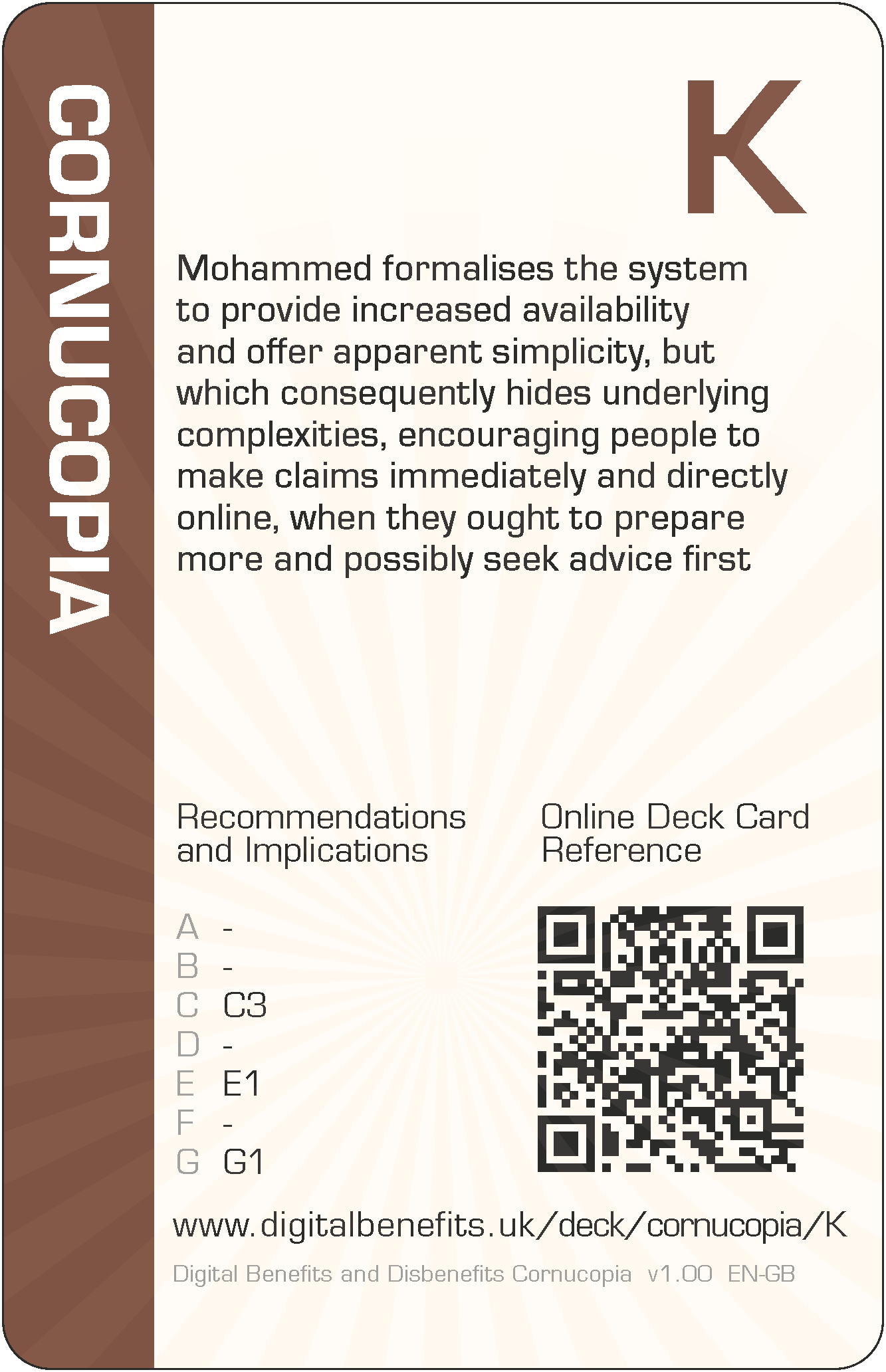Cornucopia K (CO-K) Card
DBD Cornucopia > Deck > Cornucopia > K
Card Details - King of Cornucopia
Abbreviation
CO-K
Card's focus
The focus of this card is hiding complexities
Threat to claimants
Mohammed formalises the system to provide increased availability and offer apparent simplicity, but which consequently hides underlying complexities, encouraging people to make claims immediately and directly online, when they ought to prepare more and possibly seek advice first

Threat to claimants
Mohammed formalises the system to provide increased availability and offer apparent simplicity, but which consequently hides underlying complexities, encouraging people to make claims immediately and directly online, when they ought to prepare more and possibly seek advice first.
Some examples of how this threat could lead to harms (negative effects on claimants)
The design recommendations and implications relevant to the card are listed below in the next section, but even those can be somewhat abstract and difficult to think about during practical day-to-day implementation. Therefore, some example harms are provided to complement the more formal research outputs. These examples are unique per card, and are only published on these web pages (i.e. in no other project outputs).
- Claimants do not realise what they have to do to make a successful claim, and simply proceed to complete the online forms as quickly as possible, failing to present their case for an award adequately
- Claimants fail to pause to seek and get professional advice, and instead complete the convenient online application themselves, missing out on an element of the award they would have been eligible for if they had known about it and understood how to request that too
The examples are to help understand the threat on the card, not to suppress thinking and innovation. Incorporating these examples exactly, or closely matching ones, should be scored down when playing DBD Cornucopia as a game.
Applicable design recommendations and implications
These are reproduced here from Research Briefing N
Reduce claimants’ interaction burdens with digital welfare
- Provide full social protection services across wider interoperable channels
Ensure all service provision and modes of assistance (e.g., provision of advice, practical support and self-help guidance) are available through multiple interaction channels (e.g., telephone, web, mobile app) which are accessible to varying resources and capabilities (e.g., communication skills, equipment, language, physical and mental abilities). Permit the use and intermixing of channels without restriction. Consider providing on-demand synchronous interactions through digital as well as other channels.
Design systems which support the division of labour with claimants' ecosystems
- Integrate accurate specific and contextual primary guidance about making claims within systems and promote secondary professional assistance
None
Signpost when additional assistance should be sought and recognise the time and effort needed to complete these activities
- Indicate to claimants when professional advice is crucial
Some activities undertaken to receive a social protection payment award require much more specialist knowledge and experience than most citizens have; such involvement can counter complexity to avoid becoming overwhelmed; increase visibility of when claimants should check whether advice can help by highlighting higher-risk parts of the process; avoid overly simplifying processes which can hide the underlying and necessary complexity of making and maintaining a claim and thus discourage seeking knowledge and experience in the wider ecosystem.
General Notes
Card values (i.e. 'King' for this card) are for game play and are not correlated with the severity of harm. This is because threats cannot be ranked directly since they can affect individuals in different ways due to situations and circumstances, or affect fewer or more claimants, or the harms can arise in claimants' support networks and wider society.
The threat description uses a person's name as the "attacker" (i.e. 'Mohammed' for this card), which can be thought of someone involved with implementation. They could have any role which influence digitisation. So they could be a database administrator, or a copy writer, or a quality assurance specialist, etc, or all of these. Everyone could have some influence on the claimant threat described. The names were randomly selected from those currently most popular as given names for boys and girls (UK Office for National Statistics).
The example harms provided are drawn from the research data (which explored not only parts of existing services but also the effects of possible changes to those), from the author's own knowledge of web application development and testing, the author's own experience of helping citizens to claim Universal Credit (UC) and Personal Independence Payment (PIP), and from suggestions submitted by other people (make a suggestion). The threats and example harms do not necessarily exist in the current UC or PIP deployments or in ecosystems around those services, but they might well do.
All the cards in this Cornucopia suit are: 2 3 4 5 6 7 8 9 10 J Q K A
The other suits in the deck are: Scope, Architecture, Agency, Trust and Porosity (plus Jokers).
